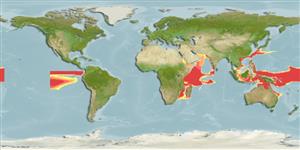>
Stomiiformes (Lightfishes and dragonfishes) >
Stomiidae (Barbeled dragonfishes) > Astronesthinae
Etymology: Astronesthes: Greek, astra = ray + Greek, esthes, -es = suit, something used to wrap (Ref. 45335); tchuvasovi: Named after Vladimir Mikhailovich Chuvasov, the leading technician of the Lab. Of Oceanic Ichthyofauna (IORAN), who is a diligent member of staff of the Laboratory and the author's companion on many research cruises (Ref. 27676).
Environment: milieu / climate zone / depth range / distribution range
Écologie
marin. Tropical
Indo-Pacific: southern part of the Arabian Sea, the Flores and Banda seas, and the equatorial Eastern Pacific.
Taille / Poids / Âge
Maturity: Lm ? range ? - ? cm
Description synthétique
Morphologie | Morphométrie
Rayons mous dorsaux (Total): 15-16; Rayons mous anaux: 13 - 14; Vertèbres: 46 - 48. In fish measuring 6 cm SL or more, aggregation of luminous tissue on head appear as a band across gill cover; one or several luminous patches on flanks, close to the medial line of body in advance of pelvic fin insertion. Chin barbel shorter than head, its swollen tip forming wide flattened lobe with oblique ribs and with small medial notch. It differs from other species of the group in having more vertebrae (Ref. 27676).
Life cycle and mating behavior
Maturité | Reproduction | Frai | Œufs | Fécondité | Larves
Parin, N.V. and O.D. Borodulina, 1996. Revision of the Astronesthes indicus species group (Astronesthidae), with descriptions of five new species. J. Ichthyol. 36(8):551-565. (Ref. 27676)
Statut dans la liste rouge de l'IUCN (Ref. 130435)
Menace pour l'homme
Harmless
Utilisations par l'homme
Plus d'informations
Noms communsSynonymesMétabolismePrédateursÉcotoxicologieReproductionMaturitéFraiRassemblement de ponteFéconditéŒufsDéveloppement de l'œuf
Taille/ÂgeCroissanceLongueur-poidsLongueur-longueurFréquences de longueursMorphométrieMorphologieLarvesDynamique des populations larvairesRecrutementAbondanceBRUVS
RéférencesAquacultureProfil d'aquacultureSouchesGénétiqueElectrophoresesHéritabilitéPathologiesTraitementNutrientsMass conversion
CollaborateursImagesStamps, Coins Misc.SonsCiguateraVitesseType de nageSurface branchialeOtolithesCerveauxVision
Outils
Articles particuliers
Télécharger en XML
Sources Internet
Estimates based on models
Preferred temperature (Ref.
123201): 20.9 - 28.6, mean 26.5 °C (based on 73 cells).
Phylogenetic diversity index (Ref.
82804): PD
50 = 0.5000 [Uniqueness, from 0.5 = low to 2.0 = high].
Bayesian length-weight: a=0.00417 (0.00171 - 0.01014), b=3.05 (2.83 - 3.27), in cm total length, based on LWR estimates for this (Sub)family-body shape (Ref.
93245).
Niveau trophique (Ref.
69278): 3.9 ±0.6 se; based on size and trophs of closest relatives
Résilience (Ref.
120179): Haut, temps minimum de doublement de population inférieur à 15 mois (Preliminary K or Fecundity.).
Fishing Vulnerability (Ref.
59153): Low vulnerability (10 of 100).
